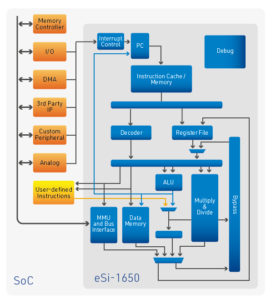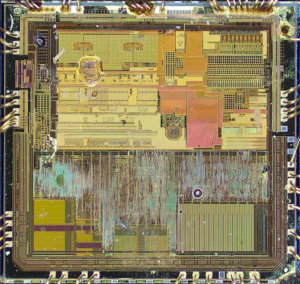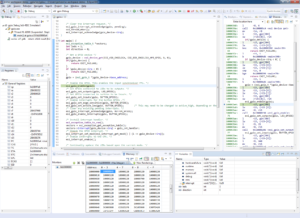eSi-1650
16-bit RISC IP, Low-Cost & Low-Power CPU with Cache
Our eSi-1650 16-bit CPU IP core is an extremely small, low-power processor with an instruction cache. The low gate count and cache feature provides a very power and area efficient solution for mature process nodes using OTP or Flash for program memory.
Document Downloads
16 bit RISC IP: eSi-1650 Technical Overview
Features
- 16-bit RISC architecture
- 16 or 32 general purpose registers
- 92 basic instructions and 10 addressing modes
- Supports up to 74 user-defined instructions
- 5-stage pipeline
- Optional memory protection unit (MPU)
- Configurable instruction cache (1-64kB, direct mapped or 2 or 4 way associative)
- AMBA AHB buses and APB peripheral bus
- Optional support for user and supervisor modes
- Up to 16 vectored interrupts plus NMI and system call
- HW nested and prioritizable interrupts
- Fast interrupt response time of 6-9 cycles
- JTAG or serial debug, with optional trace and performance counters
- Up to 2.81 CoreMark per MHz
- Multiprocessor support
- Intermixed 16 and 32-bit instructions result in exceptional code density without compromising performance
- ASIC performance (Typical 28nm):
- Up to 1 GHz
- From 10k gates
- From 3.2uW/MHz
- High quality IP:
- Verilog RTL
- DFT ready
- Silicon proven
- C and C++ software development using license-free toolchain, under industry standard Eclipse IDE
- Easy migration path to a 16-bit version without caches or to a 32-bit version
Architecture
The eSi-1650 16-bit CPU with instruction cache is targeted specifically for low-power applications, where typically an 8-bit CPU may have previously been used or where a 32-bit CPU is too big or power hungry. The instruction cache provides a high performance, area and power efficient solution when running from on-chip NVM or Flash.
The use of the cache allows higher CPU frequencies when in mature technologies as frequency is typically limited by the memory speed. Power is reduced as a small cache require less power to read than flash. A cache can be much smaller than a full shadow RAM.
Even though it is 16-bit, the gate count is equivalent to many 8-bit cores due to the simplicity of the RISC pipeline. With a wider datapath and 16 general purpose registers, application programs are able to execute in far fewer clock cycles. This can save a significant amount of power by either allowing the CPU to be clocked at a lower frequency or by being able to enter a power down state sooner.
The eSi-1650’s instruction set includes a variety of arithmetic instructions such as a full 32-bit multiply, multiply and accumulate and divide. There are also a number of optional application specific instructions and addressing modes. Bit manipulation instructions such as bitfield extract and insert, count leading zeros, population count, find first set and bit reverse can be included. Integer square root, absolute value, min/max, CRC and parity are also available. Wait-for-interrupt instructions allow fast entry to low power states, enabling clock and power gating.
For those applications that require extreme performance or ultra low power operation, user-defined instructions and registers can be implemented.
The processor supports both user and supervisor operating modes, with privileged instructions and memory areas via the optional MPU, to allow an O/S kernel to be fully protected from user applications.
Hardware debug facilities include hardware breakpoints, watchpoints, trace, performance counters, null pointer detection and single-stepping for fast debugging of ROM, FLASH and RAM based programs.
Toolchain
The toolchain is based upon the industry standard GNU toolchain, which includes an optimising C and C++ compiler, assembler, linker, debugger, simulator and binary utilities. All these tools can be driven by the customisable Eclipse IDE or from the command line.
The debugger can connect to HW targets via a low cost USB-JTAG adapator and RTL simulation via a Verilog PLI library.
Complete C and C++ libraries are supplied. Ports of Micrium’s uC/OS-II RTOS, ThreadX, FreeRTOS and the lwIP TCP/IP stack are available. The toolchain is available for both Windows and Linux hosts and is available to use at no additional cost.
IP Delivery
The eSi-1650 is delivered as a Verilog RTL IP core. The design is target technology independent and DFT ready, supporting full scan insertion for all flip flops and memory BIST. Example scripts are provided for popular EDA tools.
A selection of AMBA peripherals can be supplied with the core, including: UART, SPI, I2C™, I2S, Timer, PWM, Watchdog, GPIO, PS/2, RTC, Ethernet MAC, USB, FIFO, Scatter-Gather DMA, AES, SHA, ECC and a quad-SPI Flash interface. By using an industry standard bus, a wide range of 3rd party IP cores are compatible with the eSi-1650.
eSi-RISC can generate a multilayer AHB matrix and APB bus to connect the eSi-1650 CPU, memory and peripherals, according to a customer’s specification.



